Most of the people who lived here gained all or part of their livelihood from commercial fishing or sailing, guiding their boats through whatever nature provided in the way of weather . . . They developed a strong community spirit and their family ties were extensive. [Sanford Sydney Eves: “Simcoe Island, an Eves Perspective”]
Simcoe Islander II, 2022
It may have been the best Christmas present Simcoe Islanders could have received – the arrival of their new ferry, the Simcoe Islander II. It was likely a bittersweet day too, as many of them knew that the days for the original faithful Simcoe Islander ferry were numbered.
On October 28, 2021, the Ontario Ministry of Transportation delivered a news release announcing that “the Ontario government is investing $3.3 million in a new ferry for the Simcoe Island community . . . the ferry will be built by Heddle Shipyards in Hamilton . . .” The release also noted that “the province will pay the total cost of the new Simcoe Island Ferry and the Township of Frontenac Islands will be responsible for operating its service.”
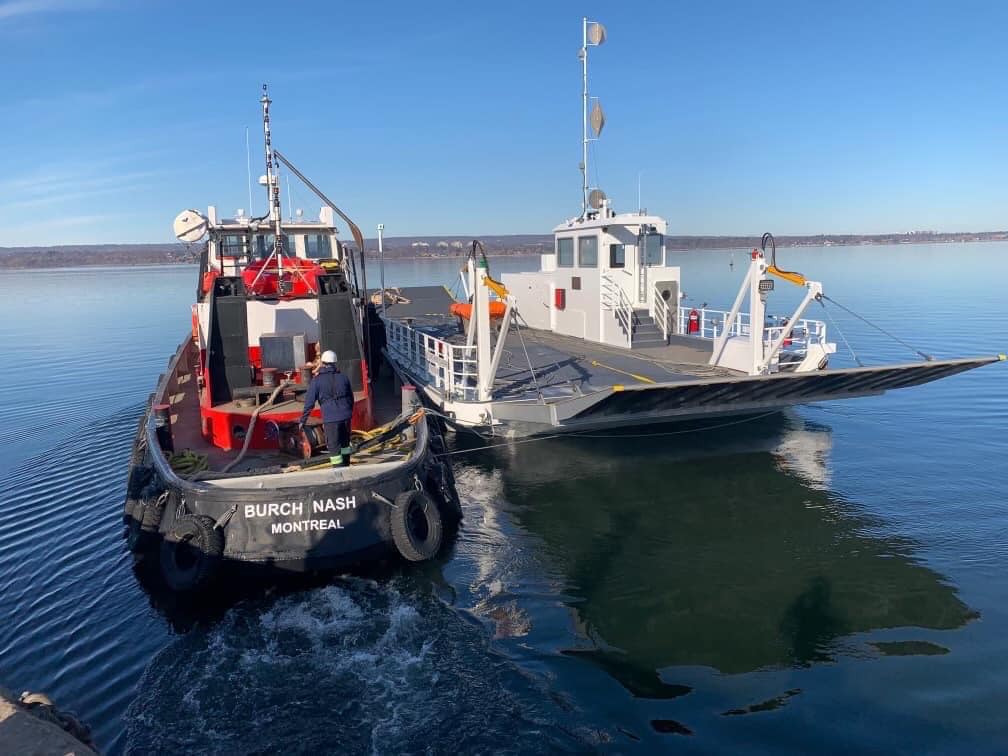
All seemed quiet on the ferry front for Simcoe Island until November 9, 2022, when The Bay Observer (Hamilton) posted a news brief stating that “Heddle hands over new Kingston ferry after landing big Coast Guard contract,” however, few details were mentioned. Then on December 20, 2022, a photo appeared on social media of the new ferry sitting in Oshawa Harbour with the tug Burch Nash, on a calm, clear morning. She was enroute – and arrived later that day at Simcoe Island. With photos being shared of her arrival on social media, the excitement and congratulations poured in from all over. The operators worked hard over the next few days to prepare the new ferry for service, which did not go without its challenges, including big winds and blinding snow over Christmas, and by New Year’s the new two-cable ferry was up and running.
Earlier this past spring, from my vantage point by the east cable, I watched the brand new Simcoe Islander II approach her dock on the Wolfe Island side, just after leaving Simcoe Island. A beautiful ship, just built at Heddle Shipyard in Hamilton, arriving just before Christmas under tow from Heddle’s tug Burch Nash. Atop her modern wheelhouse, prominently displayed on her mast, are two spheres with a middle diamond indicating “Vessel Restricted in Ability to Maneuver.” She is a cable ferry like her predecessor. She can carry eight cars or one transport, compared to the earlier boat’s three cars and no transport truck. This afternoon, she was riding her cables hard to the west because of a brisk, easterly wind. At the controls, in her modern wheelhouse, was operator Don Eves.

She was over too far westward of her dock as she approached. Don slowed as he came up to the west corner, waiting for a lull. When it happened, Simcoe Islander II drifted back into place and was lined right up with her ramp. Like every operator before him, Don eased ahead, and the ferry made a perfect, gentle landing into her berth. I was invited aboard and given a private tour. The spotless engine room contains a large spool winding 1500 ft of cable in and out on every trip. The 130 hp turbo charged John Deere engine provides power. Don Eves gives me a rundown on her up-to-date onboard safety equipment.

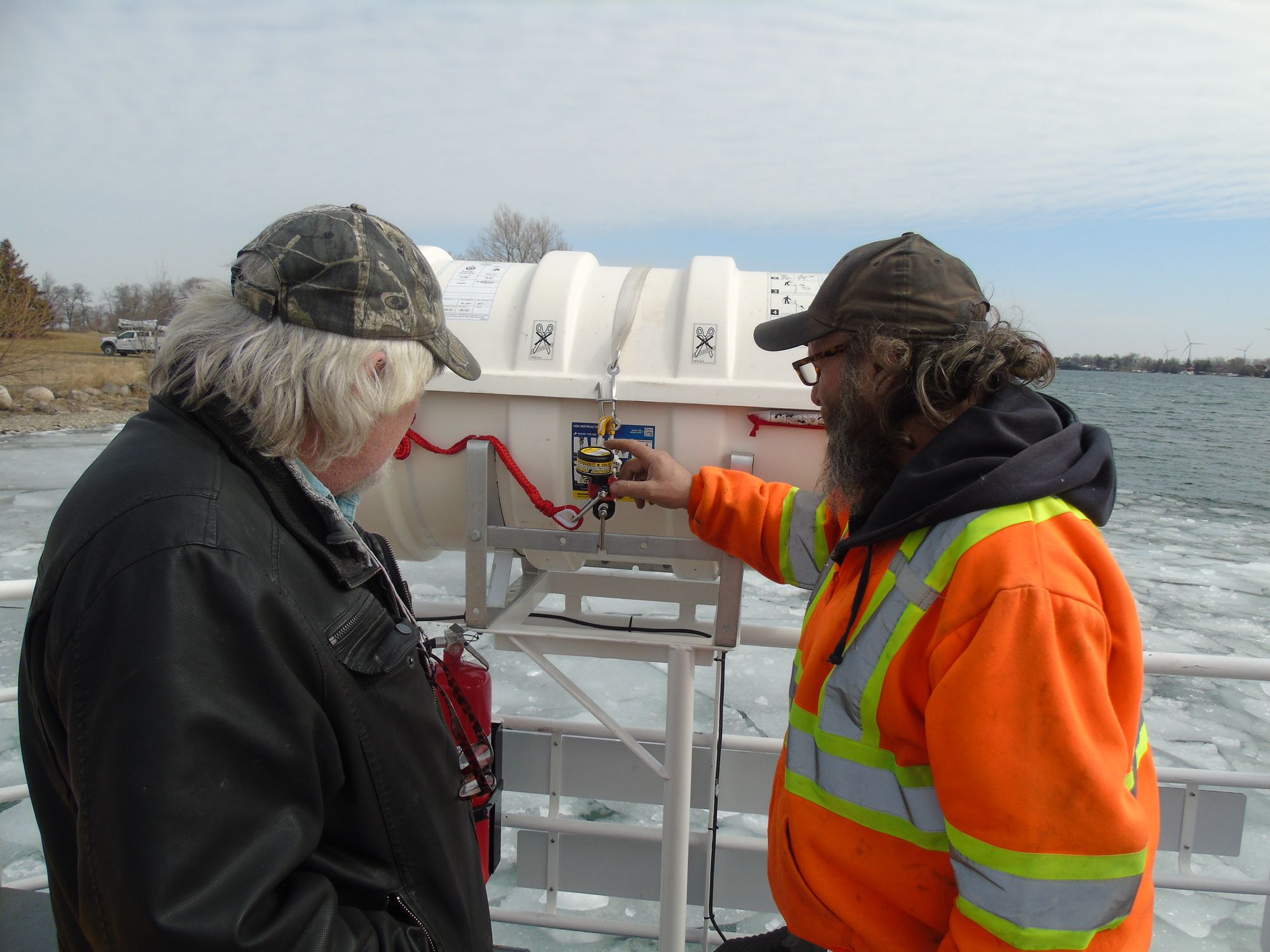
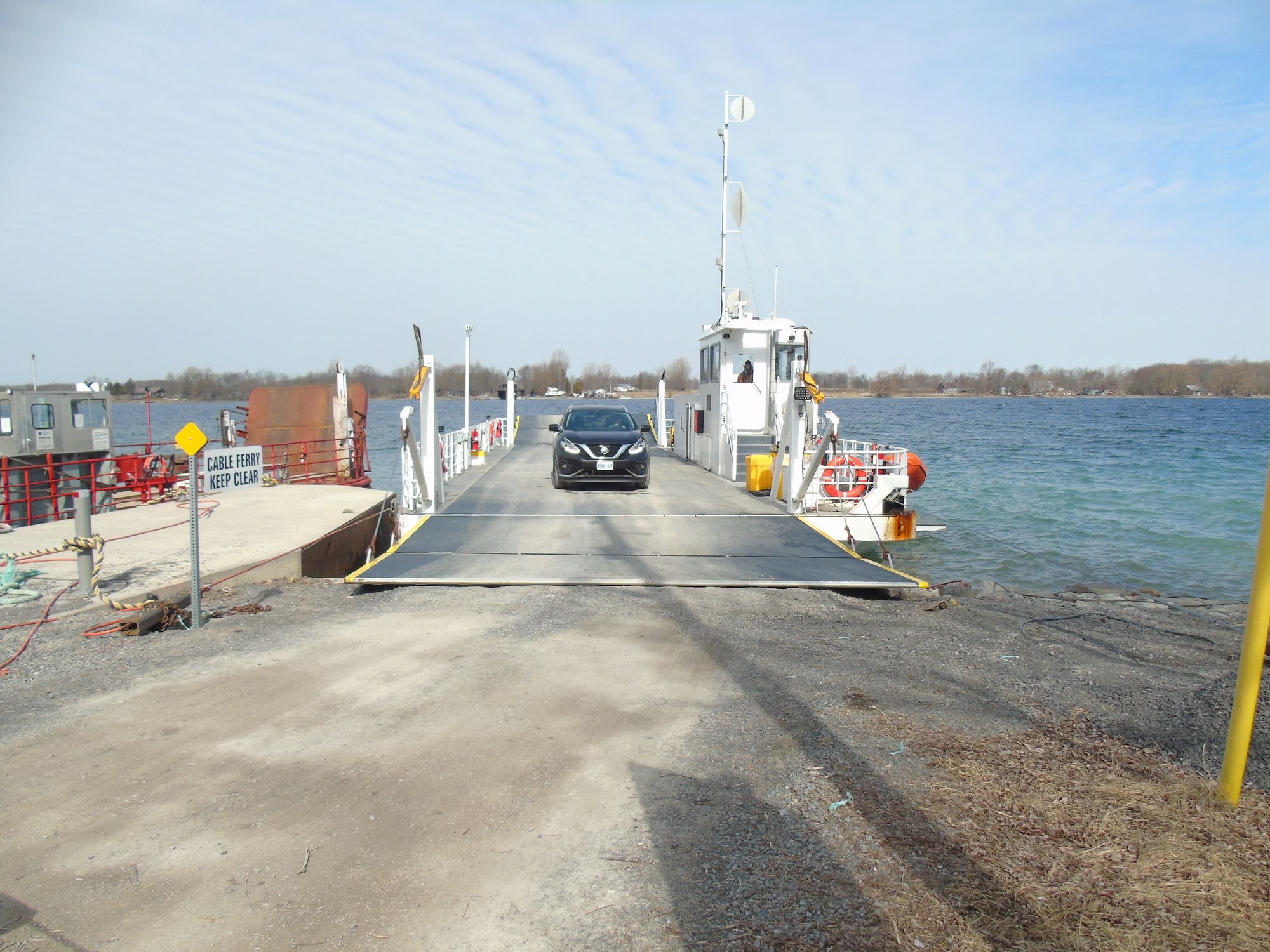
A week later, Operator Joe Taggart was ‘at the wheel’ this time. While waiting, we had time to look at the ol’ girl, securely tied to the west side of the ferry pier. The original Simcoe Islander, looking tired and worn, had been in service since 1964. Since we were waiting for the new boat to come across, we ventured onto the pier. Sadly, she looked all of her 59 years. The well-worn oak planking that hundreds of vehicles had driven on was badly splintered; she was listing slightly to port (or starboard, depending on how you looked), with layers of peeling paint. You could see where her cable – gone now – ran clearly through the aluminum ‘wheelhouse,’ probably soaking everyone inside as she travelled, just like it did with the wooden ‘wheelhouse’ structure that was there before.
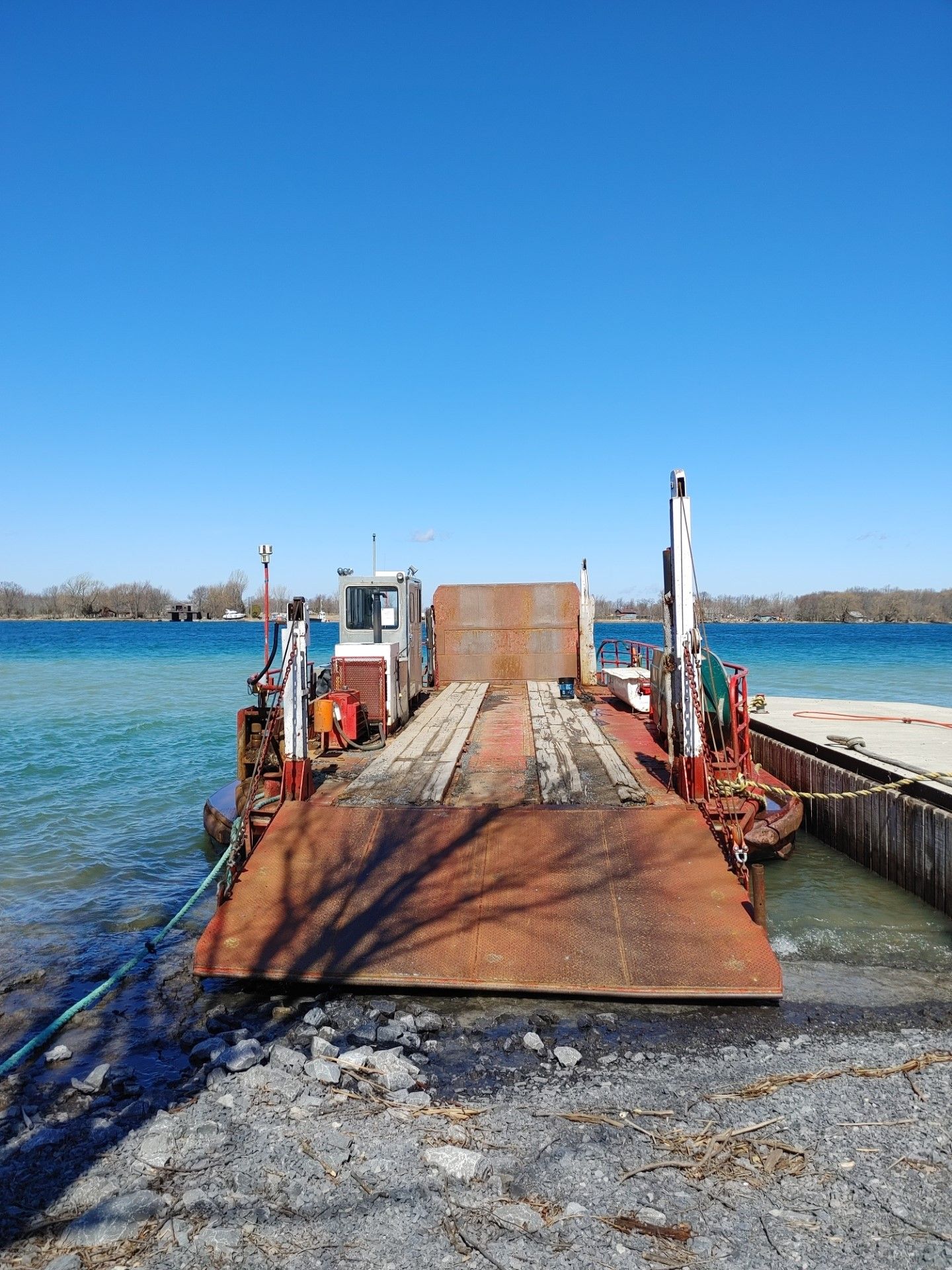
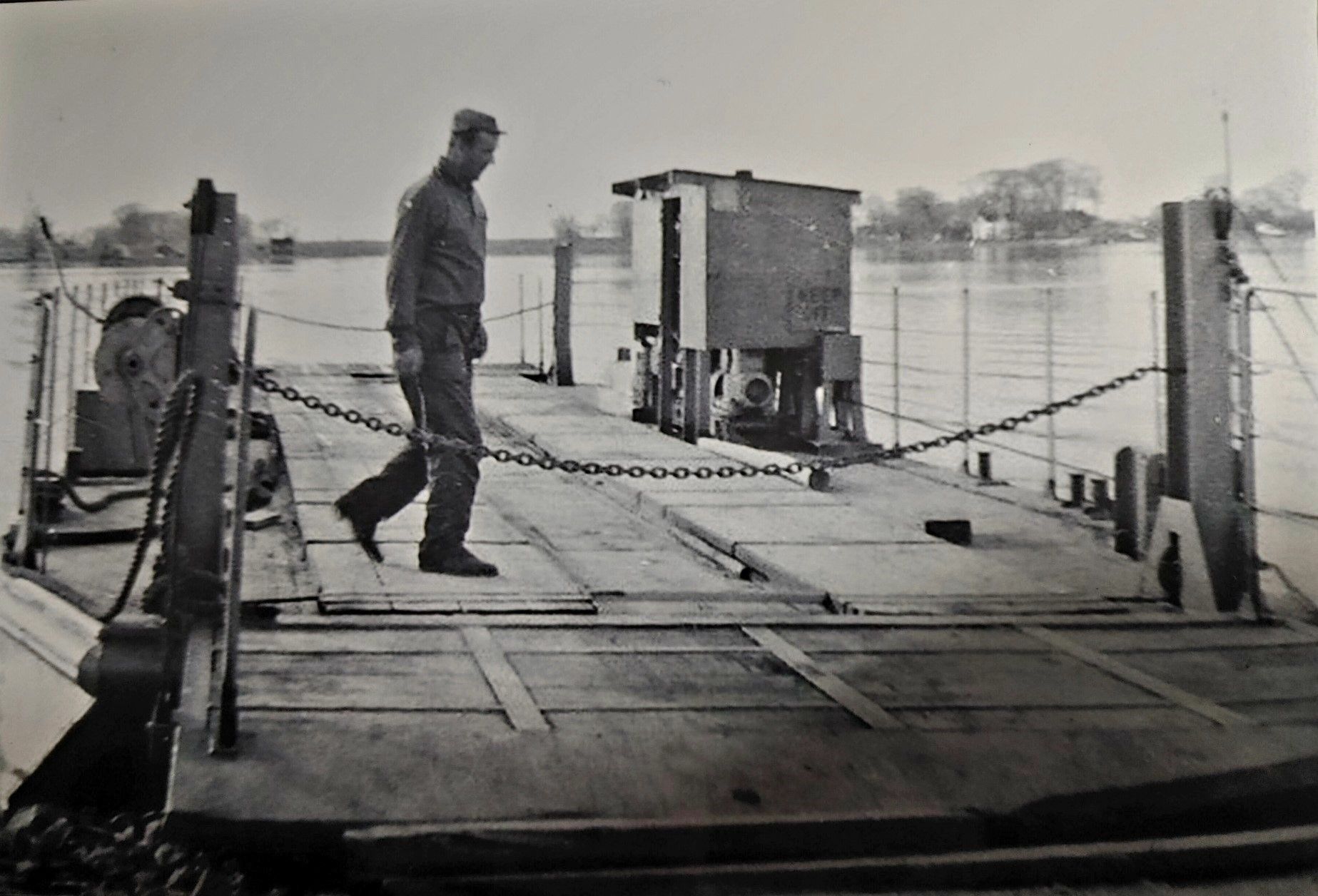
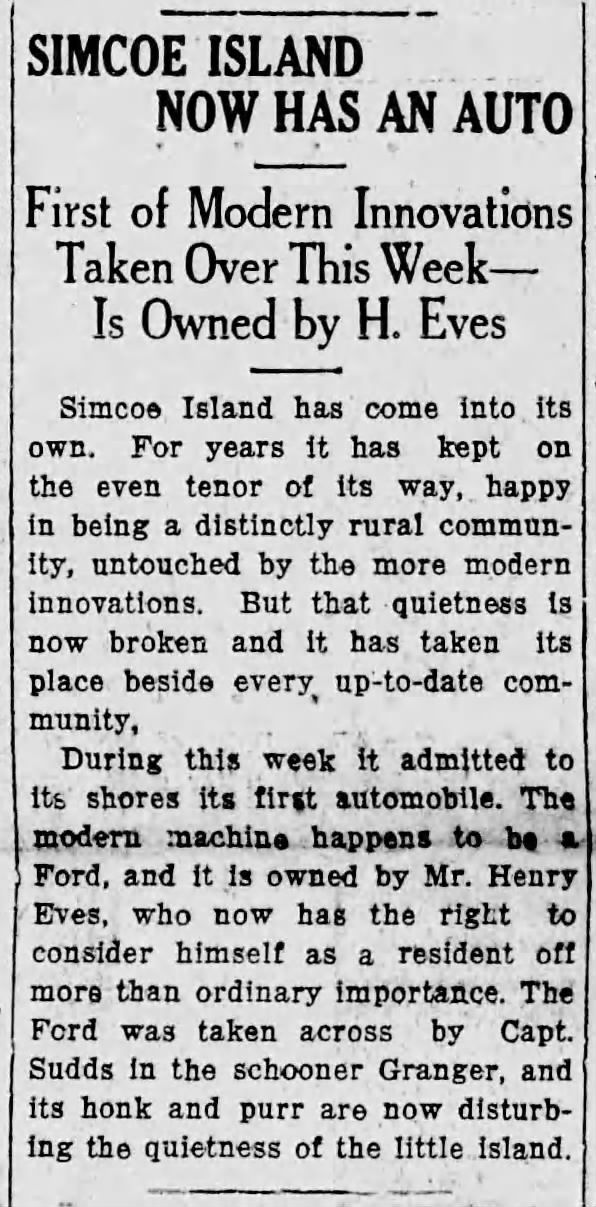
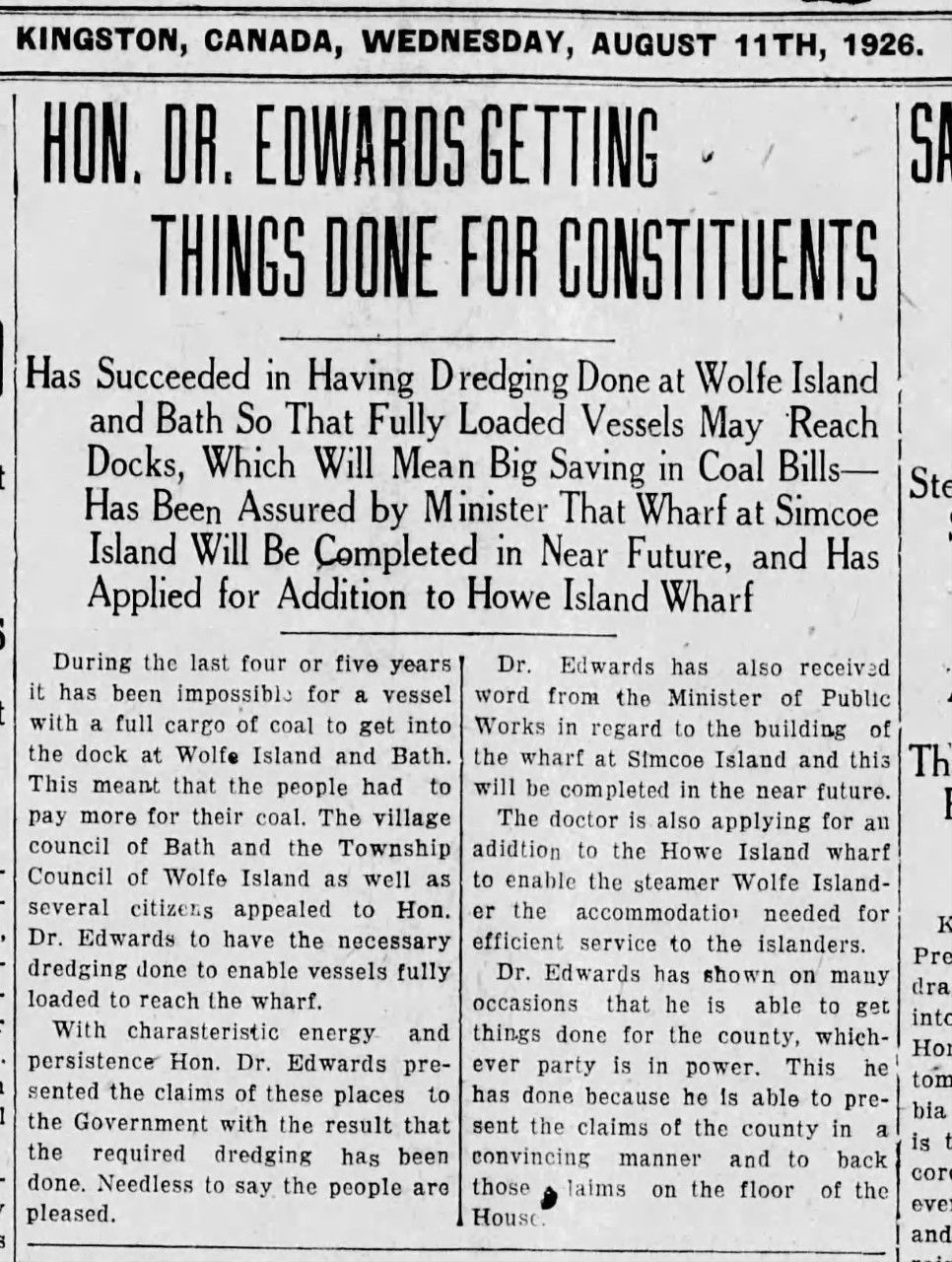

During the 1800’s before the cable ferry Simcoe Islander was provided in ‘64, periodic stops were made at Channel Grove, a large hotel at the eastern end of Simcoe Island by passing ferry steamers on their way to Cape Vincent, New York. Former Wolfe Island ferries would stop once a week at a newer wharf, where the Simcoe Island ferry lands today, returning that same day. The ferry would then land directly across the channel at nearby Spoor’s (later Flynn’s) dock on Wolfe Island. But just how did Simcoe Islanders themselves actually cope with sporadic ferry service before getting their own Simcoe Islander ferry?
If she could only talk. But she can’t so we asked around and these are the comments we received:
Just Before and After 1964
Donna Bennett: “I remember taking the Wolfe Islander II when it came to Simcoe Island once a week on Thursday. All business had to be done in Kingston on that day or wait until the ferry returned next week. You didn’t want to forget anything on your grocery list.”
William Kelly: “Bill Orr lamented that the cable ferry changed the way of life for Simcoe Islanders. It was a very isolated community prior to 1964. The Wolfe Islander II came Thursday mornings and brought you back on the 3:30pm trip, after a day in Kingston. It landed where the Simcoe Islander lands now on Simcoe Island and then landed at Flynn’s dock on Wolfe Island. That dock is gone now.”
Donna Bennett: “The new Simcoe ferry (1964) meant freedom! We could head to Kingston every day of the week. It was great! Nelson Eves was the only operator at that time, and he worked seven days a week so that islanders and cottagers had the luxury of coming to or leaving the island any day of the week. We could go visit family and friends on the weekend. It meant very big changes for Simcoe Islanders.”
“Simcoe Island was quiet, and you pretty much knew everyone you met before the Simcoe ferry arrived. There were fewer than ten cottages, and everyone had their own boat. After the ferry came into operation, the number of cottages multiplied many times over, and there were lots of new seasonal neighbours.”
William Kelly: “The Simcoe Islander was often treated as our own private transport. The boys – as my grandmother referred to them – George, Sid, and Nelson (Eves), would lay off, and if you were not known to them, well – you had to state your business.”
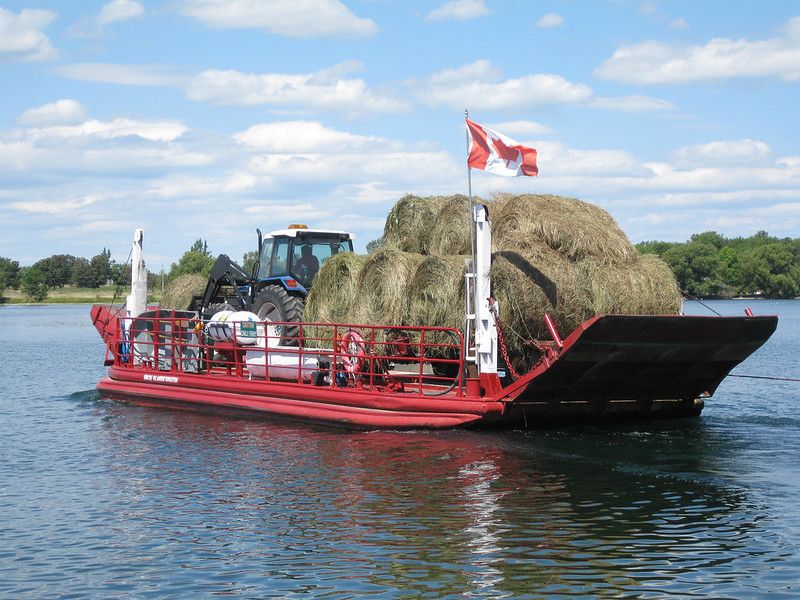
Marilyn Eves: “Simcoe Island life isn’t for everyone. I have a lot of memories of tough ferry operators in harsh weather, working to get me to my job or school, back in the day. Lots of times rides were kindly provided when the ferry was unavoidably out of service, by those same men – in their own boats – before that was no longer allowed.”
William Kelly: “There eventually came a posted schedule: ‘Subject to Change without Notice’. Usually the operator was haying, fixing a tractor or needed a nap. We referred to this as ‘Simcoe Island Time’. There was a complaint about the lack of accountability to the town council (of Wolfe, Garden & Simcoe Is.). In response, some of the operators would only run at the scheduled times. Didn’t matter if there were vehicles lined up. One would have to wait for the next scheduled trip. Luckily it was short lived and compromises met.”
Edward Eves: “My father Sydney was an operator from 1978 for a number of years. Like every job dad undertook, he took it seriously and professionally. Dad didn’t leave his ferry post to do other jobs! I know, because I was there. Early operators only got the fares as a wage. Not many people lined up for that job.”
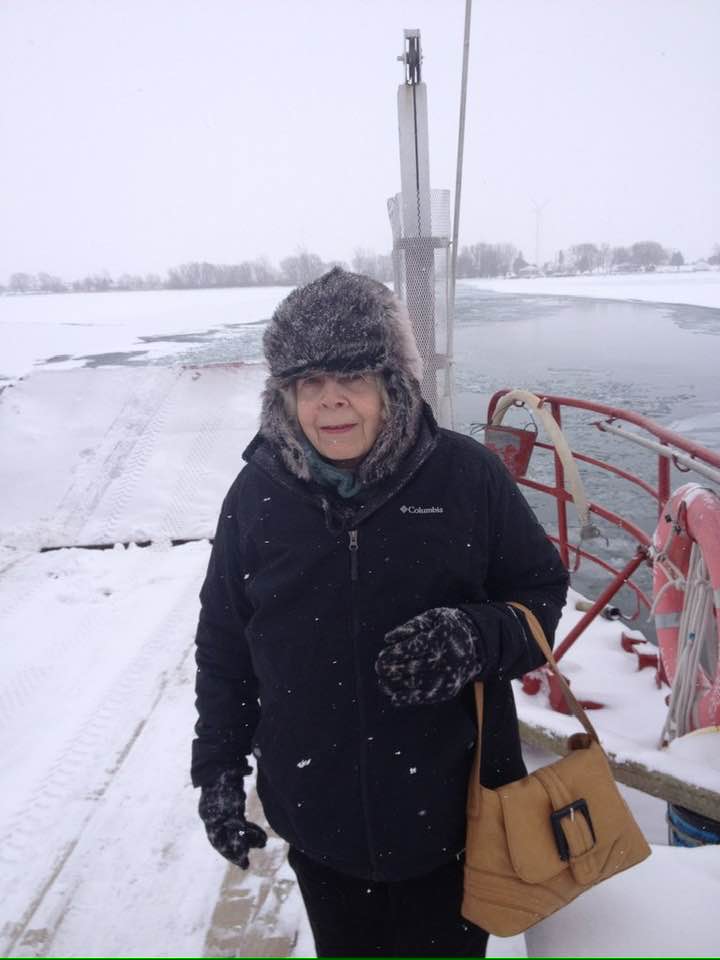
Continuing School from Simcoe Island
Brenda Eves MacDonald: “One overlooked advantage of having the Simcoe Islander was the impact on the education of the island children. We were the first generation to be able to live at home (on Simcoe Is.) and attend high school in Kingston.
Susan Eves: “I usually, no, make that always, was hoping that something would happen so we couldn’t get to school that day. For example: cable would break, pack ice would jam into the dock…
“But our operators/uncles were pretty dedicated to getting us there and knew what they were doing. In really bad weather we could pretty much crowd into the little cabin (on the ferry).”
Brenda Eves MacDonald: “My dad always made sure that we knew how fortunate we were to go to high school, and he did everything in his power to get us there. My sister Donna was the first student of the SS 1 school to graduate from grade 13 and go to university.”
Gord Orr: I went to high school in the village in 1955 and 1956. Rode my bike to Belyea’s – drove my boat over to Wolfe Island – rode to the village morning and night – I would stay at Mrs. MacDonalds in the winter.”
Wintertime, Ice and No Ferry Service
Donna Bennett: “Winters without ferry service deterred many from living there (Simcoe Island) year round. Often my dad and uncles had boats and later air boats that were used to go back and forth on the Bateau Channel in the ice break up season. Those who didn’t have boats often thumbed a ride in one of these. I don’t think anyone was turned away if they asked for a ride.”
Edward Eves: “Dad and I were taking the milk cans across the ice in the 70’s as the ferry wasn’t running. In March, like most years, there were holes in the ice where the current was starting to work. We had a sleigh behind a snowmobile with a long rope to distribute the weight. Dad walked ahead with a long pike pole to check the ice and was carrying an inflated inner tube. He was picking the best route between the holes for me to follow slowly with the snowmobile.”
Part way across he walked back and put the inner tube over the windshield of the snowmobile and said, ‘You better have this instead of me.’ But you know, he had been through lots of adventures before and I wasn’t afraid. Dad knew ice.”
Brenda Eves MacDonald: “March break on Simcoe Island was not a tropical vacation to a tropical destination!
“Mid-March meant the ice was starting to break up in the Bateau Channel and there was milk that needed to be taken to the factory on Wolfe Island. On one particular day, dad hooked up the big farm sleigh to the tractor and made his way down the island where he met up with his brother Roy. As usual there were a couple of us kids along to lend a hand. Together we made our way along the shoreline, to the very end of the island where there was a narrow opening in the ice. Dad [Sidney] and Roy launched a small boat, and we loaded the milk cans and made our way across the water to Wolfe Island.
The only place we could land was at the bottom of the hill where the SS school stood. That meant we had to carry the 80 lb. milk cans (80 lbs. milk + 10-15 lbs. for the can) up the side of that steep, rocky hill. After multiple trips we loaded the cans into the truck, and we were off to the factory.
“On the way back we picked up a few groceries from Coffee’s store, packed them into the clean milk cans and made our way home to finish the farm chores.
“I wanted people to know how much of a lifeline THAT ferry was for Simcoe Islanders and when it couldn’t run in the winter there were very real hardships that we faced. For those of us who lived, worked and went to school on Simcoe Island, it was a vital link to Wolfe Island and Kingston.”
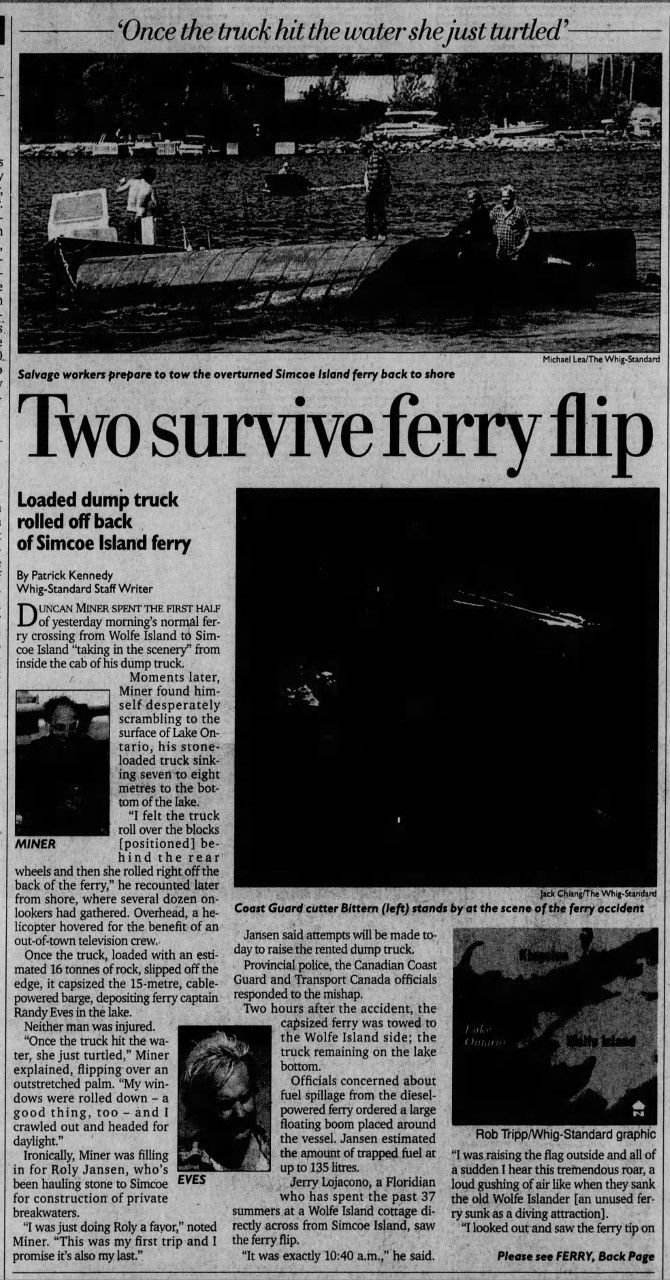
Springtime 2023
There are two cars aboard Simcoe Islander II as operator Joe Taggart pulls up the shore chain and then, walking aboard, lifts the ramp. With the afternoon sun reflecting her brilliant white coat of paint, he slowly puts her in gear and gently leaves the Wolfe Island dock with her twin cables slowly dropping down and out of sight. She is trimmed perfectly level, both port and starboard, fore and aft.
The new ferry follows the same on-demand schedule as her tired, worn-out, forerunner had done since 1964. Today’s operators continue the same dedicated service as their predecessors. The new boat can safely carry almost anything that can travel down the highway. Amherst, Wolfe, and Simcoe Islands have finally been gifted with three brand new ferries, with larger carrying capacities.
Complications have held up putting the Amherst Islander II and Wolfe Islander IV ferries into service. Simcoe Islander II went into service within a few days of her arrival, without any ceremony.
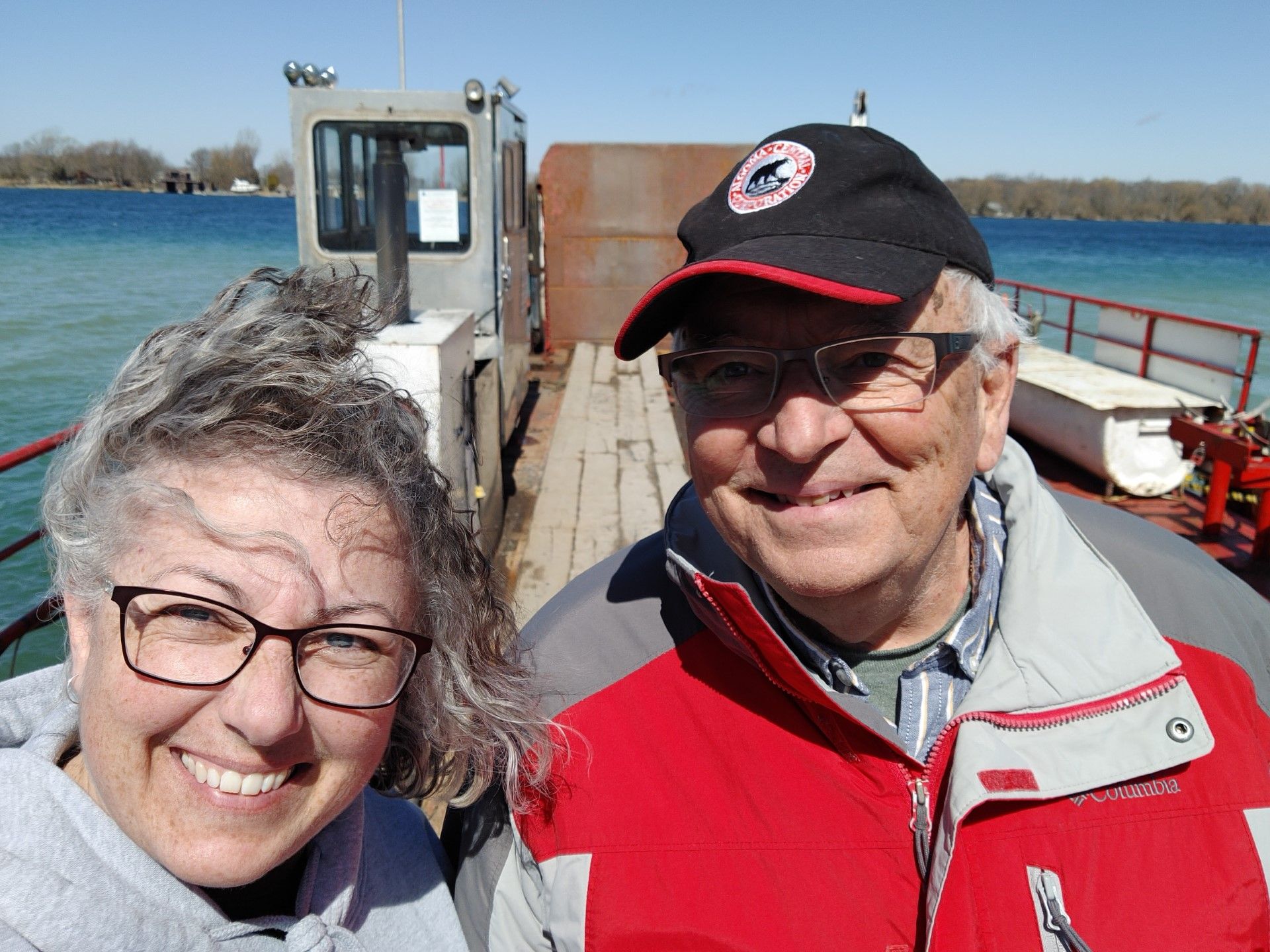
Ferry Operators over the Years
Since 1964, the Eves family have been the primary operators of the Simcoe Island Ferry.
These operators have included: Nelson Eves - 1964; George Eves - 1971; Ron Eves - 1971; Sidney Eves - 1978; Randy Eves - 1985; Don Eves – current.
More recently, other operators have joined the crew: Kevin Frost, Keith Greenwood, Eddie Taggart, Mike Calthorpe, Joe Taggart, along with part-time operators: Aaron Koloseike, Brad Brown, and Keith McDonnell.
The operators have two shifts: 5:30 am – 3:00 pm; 3:00 pm – 12:15 or 1:15 am.
The ferry runs on demand: Monday -Thursday: 5:45 am – 12:15 am; Friday 5:45 am – 1:15 am; Saturday 6:00 am – 1:15 am; and Sunday 6:00 am.
By Brian Johnson & Shauna Kingstone
Brian Paul Johnson was one of five captains of the Wolfe Island car ferry, Wolfe Islander III. He worked for the Ontario Ministry of Transportation for more than 30 years. He has been providing historical articles for TI Life since June 2009 with his first article, The Wolfe Islander is Missing This was followed by an impressive 54 others! Click here and here to see many of Brian’s contributions!
Shauna Kingstone is the 2023-24 President of the Wolfe Island Historical Society. She is interested in local history, particularly the history of Kingston and the Thousand Islands and is a self-described amateur researcher. (Editor's note: an amateur who is happy to share her knowledge - which is much appreciated.)
Posted in: Volume 18, Issue 11, November 2023, History, People, Places
Please click here if you are unable to post your comment.
